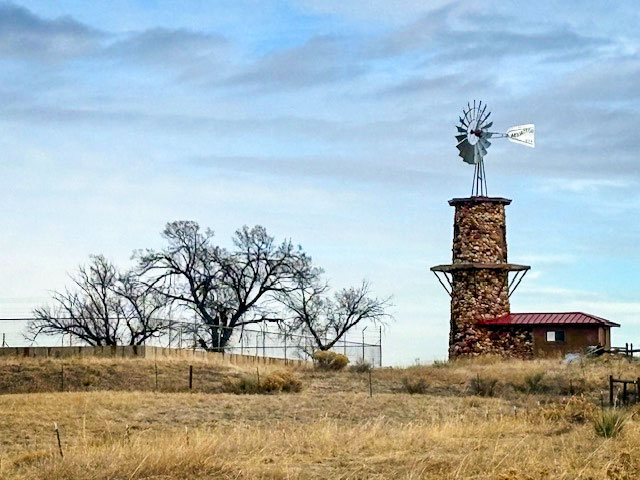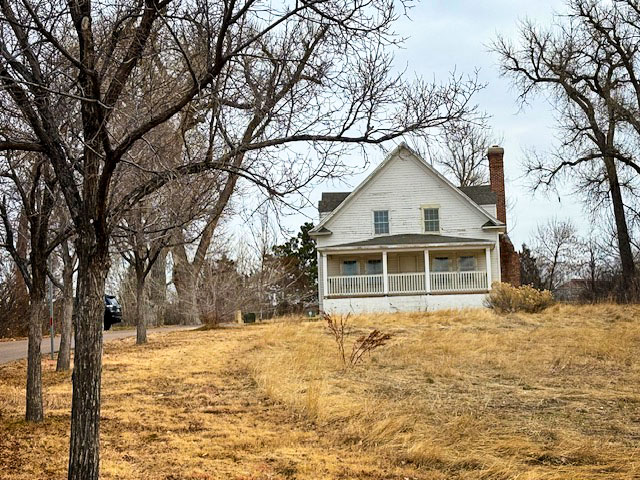Chasing windmills

A windmill at the access gate of Wind Crest. Below it, a time capsule is buried, to be opened in 2035.
Windmills played important roles on our county’s often-parched ranchlands. Simple and necessary, some also see them as works of art, even symbols.
In 2021, the Highlands Ranch Historical Society published an informative piece on those remaining windmills that we could claim as our own. Shirley Cavenaugh, the author, gave them new life and prominence.
A prize for “biggest and best” would have to go to the one remaining at the Highlands Ranch Mansion. One-hundred and thirty-five years old, the windmill’s location and size also make it an attractive landmark for the area. Uniquely-constructed with sized, local fieldstone cobble, the reservoir at its base accumulated water for gravity-fed distribution to the farthest reaches of the ranch.
A story worth sharing comes from former owner, Lawrence Phipps. The reservoir required periodic cleaning and since local rattlesnakes so loved the spaces between the fieldstones, the man doing the work carried a sidearm. It was risky business!
Especially notable among the breed was the Big Dry Creek Cheese Ranch Historic Park’s windmill. From 1917, it was a significant landmark in what is Highlands Ranch today. Over the years, the farm and ranch it watched over had accommodated the Welte and Gassner families, processing local milk to specialty cheeses, especially Limburger, highly talked up in dairy journals of the day. The windmill’s base was also the scene of many neighborhood beer parties, likely modeled after Oktoberfest in Munich, Germany. Weathered and buttressed over time, the Highland Ranch Metro District oversees the windmill, while a curated series of storyboards tell a lively story of the family histories.
There were two more windmills in the Highlands Ranch Backcountry. One, a Fairbanks Morse windmill toiled for 75 years on Henry Failing’s homestead below the south flank of the Cherokee Ranch & Castle. Forlorn and shot up with bullet holes when last seen, it remains a wounded sentinel of pioneer ingenuity.
Some miles north, Lorina and Lafayette Griggs operated the Griggs Pine Tree Ranch from 1878 to 1925. Only dilapidated buildings remain today. One might imagine the wind whistling through the corridor, driving the blades of a geared Aermotor mechanism, pumping water that would sustain the stock grazing nearby for another day.
Thirty-five years ago, the Highline Canal lazily wound its way through our county and contented cattle grazed among massive cottonwood trees thriving on the water. Standing on it, one had an unobstructed view of the city of Denver from its height at the I-470 and Santa Fe Road. Nearby was also the Plews Homestead (remaining today) and remnants of the family greenhouse. Beyond it was the Bowens’ Flyin B Ranch and airstrip.
Nearby, and possibly most significant windmill of all at the gated entrance of the Wind Crest senior living community. Credit goes to Wind Crest’s owners who, with it, have tastefully reminded all of the prior ranching history of the area.
Many see windmills nostalgically a thing of the past. Remember the Simon and Garfunkel song Mrs. Robinson bemoaning “Where have you gone Joe DiMaggio?” Close your eyes and envision a windmill towering above you. Feel the gentle breeze driving its spinning vanes lazily in Colorado’s bright blue heavens. Then recall those older more uncomplicated times when smiling heroes like Joe and his baseball achievements were good old-fashioned examples for all of us.

The Plews home, soon to be an event center for the Wind Crest senior living community.
Article and photos by Joe Gschwendtner